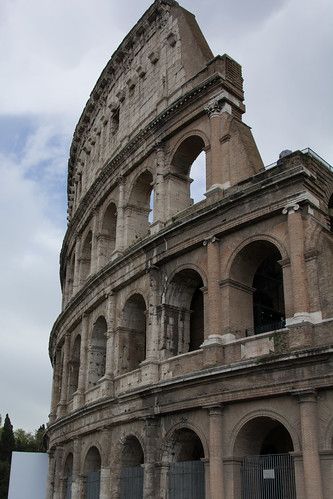
Colosseum Main Page
General Info

| City | Rome |
|---|---|
| Country | Italy |
| Website | http://www.the-colosseum.net/ |
| Place Name | Colosseum |
| Telephone | +39 06 3996 7700 |
| Postal Code | 00184 |
| Street Address | Piazza del Colosseo, 1, 00184 Roma RM, Italy |
Overview
The Colosseum, also known as the Flavian Amphitheater, is an iconic symbol of Imperial Rome. This huge oval amphitheater in the heart of Rome, built in the 70s and 80s.
Acknowledged as the largest amphitheater with a capacity of nearly 50,000 spectators, the Colosseum was primarily used for gladiatorial contests, public spectacles such as sea battles, animal hunts, executions, re-enactments of famous battles, and drama. This historic structure has survived earthquakes and looting and today remains an enduring symbol of Rome's long and tumultuous history.
- Construction: The massive stone and concrete structure highlights the excellence of Roman architecture. Key features include arches, columns and pilasters representing the three orders of Greek architecture, and the hypogea, a series of underground passages and chambers.
- Significance: in addition to entertainment, the Colosseum was a manifestation of Roman imperial power and religious traditions such as the munera, games sponsored by politicians and wealthy patrons representing their power and prestige. > strong >them>
- Preservation: Today, efforts are underway to preserve this UNESCO World Heritage Site both as a symbolic historical landmark and as a testament to humanity's incredible innovations in architecture, culture and design. "Urban Planning.< /strong> l.
```
History
The Colosseum: a great dive into the past
The Colosseum or Flavian Amphitheater is a historical monument that symbolizes the greatness of Imperial Rome. This architectural wonder was created around 80. under the patronage of the emperor Flavia.
The idea of the Colosseum was conceived by the emperor Vespasian, who envisioned a large amphitheater that would increase his prestige among the Romans, as well as an arena for public performances. After his death, his son Titus completed the construction and organized the grand opening games, which lasted 100 days.
The Colosseum primarily hosted gladiator games, dramas based on classical mythology, and public spectacles such as mock sea battles, animal hunts, and executions. The project could accommodate around 50,000 spectators to ensure everyone could see the proceedings clearly.
The magnificent Colosseum has survived the changing fortunes of time. It witnessed the fall of the Roman Empire, was rebuilt as a fortress, a Christian shrine and even a quarry before being recognized for its historical significance in modern times.
Today, this UNESCO World Heritage site is a major tourist attraction, mesmerizing with its heritage. Let's dive into the glorious past:
- An amphitheater that was more than an architectural wonder. It symbolized the power and prosperity of the Roman Empire.
- An arena that witnessed the bravery of gladiators, the intensity of public spectacles and the swings of human emotions.
- A lasting legacy that stands surrounded by modernization and offers a surreal journey back in time.
The impressive legacy and monumental grandeur of the Colosseum still fascinates and inspires, leaving an indelible mark on the sands of time.
Geography and Natural Features
Located in the heart of Rome, the Coliseum bears witness to thousands of years of natural and man-made changes. It was built on land surrounded by massive structures such as the Roman Forum and the Palatinate Hill, creating a harmonious combination of grandeur and rusticity.
The Colosseum is located in a wide flat valley surrounded by seven mythical hills. The particular location chosen was characterized by accessibility, as it was close to the Tiber River, an important source of water and transportation for Rome. In addition, it was placed in the middle of the main intersections of the city, reinforcing the essence of the Colosseum as a public arena.
The most impressive natural features influence the construction of the amphitheater. The facade, made of travertine lime, was of local origin. This natural resource was renowned for its strength and durability, giving the Colosseum its ancient status. But these elements also bore the marks of time, giving the monument a rustic charm that speaks of its history.
- Palatine, which casts long shadows over the arena, especially at sunset, giving it a sense of quiet majesty.
- The flora around the Colosseum is an important part of the ecosystem, as more than 250 species of wild flowers grow among the ruins.
In essence, the Colosseum is a testament to how humans and nature work together to create a spectacle that will stand the test of time. It is a living example of cultural geography and natural features influencing urban design.
Influence and Legacy Features
The Coliseum has left an indelible mark on the global architecture and entertainment industry. His design has greatly influenced the construction of modern stadiums and arenas around the world.
Designed to hold approximately 50,000 spectators, the Colosseum was not only an embodiment of architectural genius, but also symbolized the greatness and power of the Roman Empire. Featuring gladiator fights, public performances, and dramas based on classical mythology, this amphitheater set the standard for public entertainment venues that would evolve over the centuries.
Today, the innovative construction style has been a direct inspiration for the design of modern stadiums, ensuring efficient crowd management and optimal viewing from anywhere in the home. It also introduced the concept of "half-time" entertainment, which is a staple of today's sporting events.
- The iconic elliptical structure of the Colosseum is reflected in the design of hundreds of modern sports arenas around the world.
- Theaters and concert halls also borrowed a lot from the great entertainment spectacle of the Colosseum.
- The architecture and engineering of the Colosseum embodied much study and research, revolutionizing the field of construction.
Whether in architecture, entertainment or engineering, the influence and legacy of the Colosseum remains unparalleled and has a profound impact on our modern society.
```
References
TrendingFan Content
So far, there is no trending fan content for this particular universe. Explore all available content and find something you might like!
